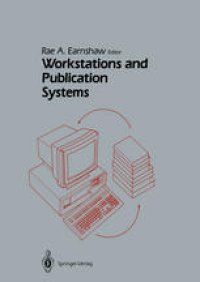
Ebook: Workstations and Publication Systems
- Tags: Printing and Publishing, Theory of Computation, Document Preparation and Text Processing
- Year: 1987
- Publisher: Springer-Verlag New York
- Edition: 1
- Language: English
- pdf
Review Office automation and associated hardware and software technologies are producing significant changes in traditional typing, printing, and publishing techniques and strategies. The long term impact of current developments is likely to be even more far reaching as reducing hardware costs, improved human-computer interfacing, uniformity through standardization, and sophisticated software facilities will all combine together to provide systems of power, capability and flexibility. The configuration of the system can be matched to the requirements of the user, whether typist, clerk, secretary, scientist, manager, director, or publisher. Enormous advances are currently being made in the areas of publication systems in the bringing together of text and pictures, and the aggregation of a greater variety of multi-media documents. Advances in technology and reductions in cost and size have produced many 'desk-top' publishing systems in the market place. More sophisticated systems are targeted at the high end of the market for newspaper production and quality color output. Outstanding issues in desk-top publishing systems include interactive editing of structured documents, integration of text and graphics, page description languages, standards, and the human-computer interface to documentation systems. The latter area is becoming increasingly important: usability by non-specialists and flexibility across application areas are two current concerns. One of the objectives of current work is to bring the production of high quality documents within the capability of naive users as well as experts.
Workstations and Publication Systems presents key aspects at the leading edge of electronic publishing systems. These state of the art topics include Page Description and Graphics, Document Structures and Editing, Workstations and Human-Interface Aspects, and Languages and Implementations. Other issues covered are POSTSCRIPT and SGML related topics, personal publishing, multi-media documents, and theoretical models and paradigms. Office automation and associated hardware and software technologies are producing significant changes in traditional typing, printing, and publishing techniques and strategies. The long-term impact of current developments will be even more far-reaching as reducing hardware costs, improved HCI, uniformity through standardization, and sophisticated software facilities will all combine to provide systems of power, capability, and flexibility. This volume addresses many of the technical issues involved in this transition. The papers combine tutorial review and detailed examination of selected areas, and should enable most readers to derive maximum benefit from the volume. This book is important for all those concerned with the design, supply, or use of publishing systems; the hardware and software issues currently being addressed; publishers of books, magazines and newspapers; text processor suppliers and users; graphics systems designers and users; personal publishing; and all those involved with the design, use, and application of workstations.